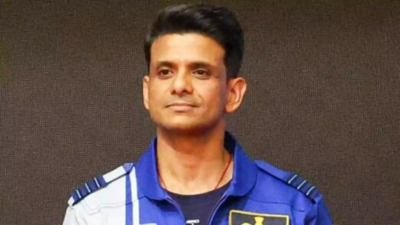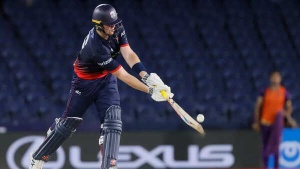The Axiom-4 mission, carrying India's Shubhanshu Shukla, alongside Anne McClain, Nichole Ayers, and Peggy Whitson, launched from NASA's Kennedy Space Center on Wednesday at 12:01 pm IST. The mission aims to transport these four private astronauts to low Earth orbit, with docking at the International Space Station's (ISS) Harmony module scheduled for Thursday at 4:30 pm IST. The crew will spend two weeks conducting scientific research.

Shubhanshu Shukla's space journey evokes national pride across India.
The journey from launch to docking is estimated to take approximately 28.5 to 29 hours. During their two-week stay at the ISS, the crew will be immersed in various scientific research and outreach activities.
The journey began at Launch Complex 39A at NASA's Kennedy Space Center in Florida, a location steeped in history as the launch site for Neil Armstrong's journey to the Moon. The Ax-4 crew, clad in specialized flight suits, arrived at the pad and boarded the Dragon capsule "C213." They conducted meticulous pre-launch checks in collaboration with SpaceX and NASA teams.
Approximately 35 minutes before launch, the Launch Director authorized fueling, after activating the crew's emergency escape mechanism. The Falcon-9 rocket was then loaded with supercooled liquid oxygen and RP-1 kerosene fuel. With five minutes remaining on the countdown, the Dragon capsule transitioned to internal power, requiring perfect synchronization of all systems for a successful launch.
At T-0, Falcon-9's nine Merlin engines roared to life, propelling the vessel skyward. Within a minute, the craft surpassed the speed of sound. The critical "Max Q" phase, where the vehicle experiences peak aerodynamic stress, occurred at 57 seconds into the flight.
The vessel maintained its precise trajectory toward low-Earth orbit (LEO), while the crew endured increasing gravitational forces.
Approximately 150 seconds after launch, the first stage detached and began its descent back to Earth, aiming for an automated landing on a platform in the Atlantic Ocean. Meanwhile, the second stage continued to propel the Dragon capsule towards its intended orbit.
Ten minutes post-launch, the Dragon capsule separated and commenced its independent flight. With its nose cone deployed, revealing vital navigation equipment, the craft achieved speeds exceeding 27,000 km/hr, completing an orbit around the Earth every 90 minutes.
Over the next 20-24 hours, the Dragon capsule executed precise orbital adjustments, performing calculated engine burns to align with the ISS trajectory. The craft employed a combination of GPS, radar, and internal sensors to maintain accurate positioning.
The Dragon capsule approached the ISS methodically, pausing at designated waypoints from 400 meters inward. Ground control granted authorization for each progression. At 20 meters, the craft's laser sensors and cameras guided it towards the Harmony module's docking port.
The docking process occurred in two stages: magnetic soft capture, followed by mechanical hard capture, creating an airtight seal.
Following comprehensive pressure and leak checks, the crew entered the ISS. The Ax-4 team then initiated their two-week scientific program, which includes research into diabetes. For Shubhanshu Shukla, this mission signifies both a personal milestone and India's expanding role in space exploration.
Newer articles
Older articles
 Smith Eyes Grenada Test Return After Injury Recovery
Smith Eyes Grenada Test Return After Injury Recovery
 Google Maps Boosts Navigation Precision with Fused Orientation Provider Update
Google Maps Boosts Navigation Precision with Fused Orientation Provider Update
 Earth Sciences Minister Rijiju Expresses Frustration Over Atos Supercomputer Delay, Jeopardizing Weather Forecast Upgrades
Earth Sciences Minister Rijiju Expresses Frustration Over Atos Supercomputer Delay, Jeopardizing Weather Forecast Upgrades
 Washington Freedom Snatch Last-Ball Win Over Knight Riders in MLC Thriller; Playoff Hopes Soar
Washington Freedom Snatch Last-Ball Win Over Knight Riders in MLC Thriller; Playoff Hopes Soar
 East Africa Rift: Mantle Upwelling Drives Birth of New Ocean, Study Finds
East Africa Rift: Mantle Upwelling Drives Birth of New Ocean, Study Finds
 Colon Cancer: Don't Ignore These 5 Subtle Warning Signs
Colon Cancer: Don't Ignore These 5 Subtle Warning Signs
 Prasidh Krishna Vows to Sharpen Bowling After Costly Leeds Performance
Prasidh Krishna Vows to Sharpen Bowling After Costly Leeds Performance
 Gavaskar Urges India to Replace Thakur with Yadav for Second Test Against England
Gavaskar Urges India to Replace Thakur with Yadav for Second Test Against England
 Rishabh Pant's Unconventional Batting Style Is Revolutionizing Cricket, Says Greg Chappell
Rishabh Pant's Unconventional Batting Style Is Revolutionizing Cricket, Says Greg Chappell
 Vitamin B12 Deficiency: Cardiologist Explains Symptoms, Sources, and Why You're Always Tired
Vitamin B12 Deficiency: Cardiologist Explains Symptoms, Sources, and Why You're Always Tired